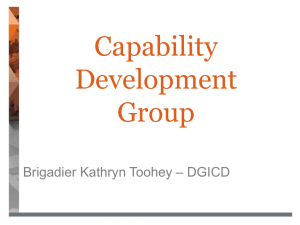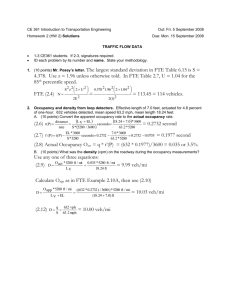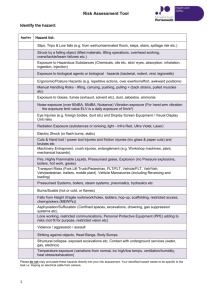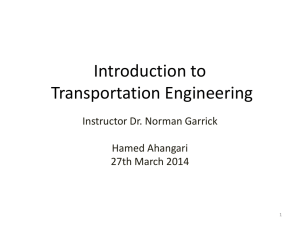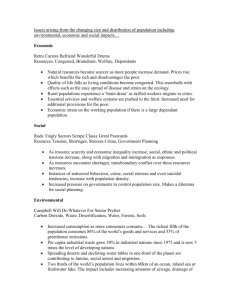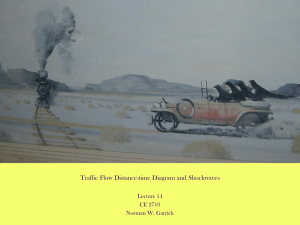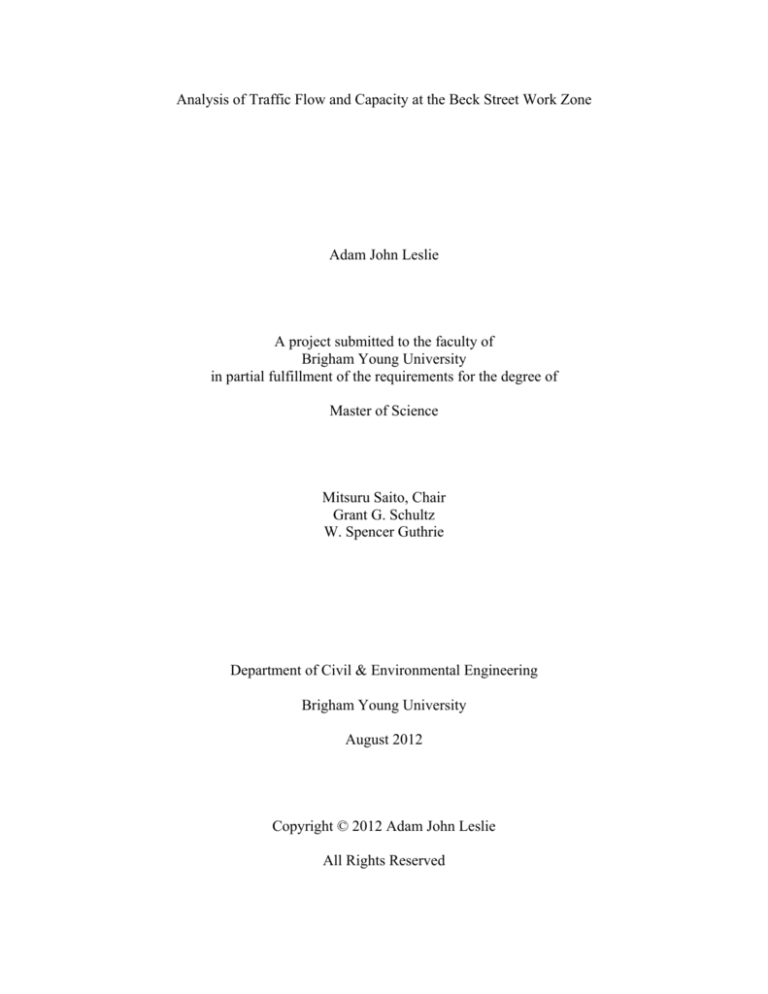
Analysis of Traffic Flow and Capacity at the Beck Street Work Zone
Adam John Leslie
A project submitted to the faculty of
Brigham Young University
in partial fulfillment of the requirements for the degree of
Master of Science
Mitsuru Saito, Chair
Grant G. Schultz
W. Spencer Guthrie
Department of Civil & Environmental Engineering
Brigham Young University
August 2012
Copyright © 2012 Adam John Leslie
All Rights Reserved
ABSTRACT
Analysis of Traffic Flow and Capacity at the Beck Street Work Zone
Adam John Leslie
Department of Civil & Environmental Engineering, BYU
Master of Science
Work zone capacity has been a significant issue, but capacity data at work zones have
been collected only sporadically. The Highway Capacity Manual 2000 provides only a limited
discussion of this issue. As more rehabilitation or reconstruction of existing highways take
place, it becomes essential that Utah Department of Transportation traffic engineers have proper
capacity estimates for different work zone configurations. These configurations include partial
lane closures, shoulder closures, narrowed lanes and lane crossings. Proper capacity estimates
are essential in order to correctly estimate capacities for these work zone control measures,
estimate possible queues that would be formed, and evaluate the effects of different work zone
traffic control measures on queue mitigation. The Beck Street work zone was selected for this
study because it provides information about Interstate 15, which is the most used corridor in the
Salt Lake City area. After models for flow rate, density, and speed were completed, the overall
capacity of the Beck Street work zone after experiencing a lane reduction from 3 to 2 lanes was
determined to be approximately 1,350 vehicles per hour per lane (veh/h/ln), much lower than a
typical one freeway lane capacity of approximately 2,000 veh/h/ln, but only slightly lower than
expected for a work zone based on an average of 1512 veh/h/ln from similar studies.
Keywords: work zone, capacity, traffic flow model
ACKNOWLEDGMENTS
I thank my graduate advisor, Dr. Mitsuru Saito, for all of his help with coursework and
with this project.
I never could have learned so much about traffic and transportation
engineering without his help. I also thank Aaron Wilson since this project could not have been
completed without the initial research and data collection done by him at the Beck Street work
zone. I am also grateful for the support from the members of my graduate committee, Dr. Grant
G. Schultz and Dr. W. Spencer Guthrie.
I am grateful for all of the support from my family. My parents have supported me at all
times and I will never be able to thank them enough. Most of all, without the support from my
wife, Roxanne Leslie, I would never have been able to complete this project.
TABLE OF CONTENTS
LIST OF TABLES ...................................................................................................................... vii LIST OF FIGURES ..................................................................................................................... ix 1 2 Introduction ........................................................................................................................... 1 1.1 Objectives ....................................................................................................................... 3 1.2 Organization of the Report ............................................................................................. 3 Literature Review ................................................................................................................. 5 2.1 Previous Studies .............................................................................................................. 5 2.2 Modeling ......................................................................................................................... 6 2.3 Summary ......................................................................................................................... 9 3 Methodology ........................................................................................................................ 11 4 Traffic Flow Analysis and Flow Models ........................................................................... 13 5 4.1 Data Preparation ........................................................................................................... 13 4.2 Traffic Flow Models ..................................................................................................... 14 4.3 Capacity ........................................................................................................................ 18 4.4 Summary ....................................................................................................................... 19 Conclusion ........................................................................................................................... 21 References .................................................................................................................................... 23 Appendix A. Examples of Data for a Typical Congested Day ............................................... 25 v
vi
LIST OF TABLES
Table 2-1: Work Zone Capacities from Previous Studies ..............................................................6 Table 2-2: Equations for Curves in Figure 2-1 ...............................................................................7 Table 5-1: Work Zone Capacities from This and Previous Studies..............................................22 vii
viii
LIST OF FIGURES
Figure 1-1: Sensor locations between 400 S and just north of 600 N on I-15 ................................2 Figure 2-1: Speed - flow rate curves for basic freeway segments ..................................................7 Figure 2-2: Greenberg model with equation ...................................................................................8 Figure 2-3: Bell curve model with equation. ..................................................................................8 Figure 4-1: Sample of raw data.....................................................................................................13 Figure 4-2: Statistical model of average speed vs. flow rate using JMP. .....................................15 Figure 4-3: Speed vs. flow rate with statistical model overlay. ....................................................16 Figure 4-4: Speed vs. density with statistical and Greenberg’s model combination overlay .......17 Figure A-1: Speed distribution for a typical day. .........................................................................25 Figure A-2: Speed vs. density for a typical congested day at sensor 5 .........................................25 Figure A-3: Speed vs. flow rate for a typical congested day at sensor 5. .....................................26 Figure A-4: Flow rate vs. density for a typical congested day at sensor 5. ..................................26 ix
x
1
INTRODUCTION
Work zone capacity has been a significant issue, but capacity data at work zones have
been collected only sporadically. The Highway Capacity Manual 2000 (HCM 2000) (TRB 2000)
provides only a limited discussion of this issue. The 2010 version contains additional work zone
information but does not yet offer information from traffic studies performed in the state of Utah
(TRB 2010). However, as more rehabilitation or reconstruction of existing highways take place,
it becomes essential that Utah Department of Transportation (UDOT) traffic engineers have
proper capacity estimates for different work zone configurations, such as a partial lane closure,
shoulder closure, narrowed lanes, lane crossing, etc., in order to correctly estimate capacities for
these work zone control measures, estimate possible queues that would be formed, and evaluate
the effects of different work zone traffic control measures on queue mitigation.
Saito et al. worked on an evaluation of a variable advisory speed system (VASS) on
queue mitigation, using the northbound approach to the I-15 Beck Street widening work zone as
a test site in March 2010 through June 2010 (Saito and Wilson 2011). In addition to the
widening, several bridges were being replaced and a high occupancy (HOV) lane was being
added. Data for this study came from March 2010 and April 2010 before the VASS system was
installed so that the VASS would not confound any results of this study. As depicted in Figure
1-1, a VASS was set up for the northbound direction using the equipment rented from ASTI
1
Transporrtation. Thiss data colleection prod
duced a larrge amount data (voluume, speed,, and
occupanccy) that can be
b used to an
nalyze traffic flow charaacteristics annd capacity aat this work zone.
Fiigure 1-1: Sen
nsor locations between 400 S and just norrth of 600 N oon I-15 (Saito aand Wilson 20011).
Work
W
zone capacity
c
neeeds to be ev
valuated forr the Beck S
Street work zone becauuse it
representts a common
n scenario for
fo Utah freeeways. The effects of a reduction ffrom 3 to 2 lanes
2
may be predicted more easily when hard data exists to support an estimated capacity for the two
lanes.
1.1
Objectives
There are two primary objectives of this study. The first is to analyze the traffic flow rate
data collected at the VASS test site (I-15 Beck Street Work Zone), create fundamental diagrams
of traffic flow, and develop traffic flow models for the work zone. The second objective is to
determine capacity of the approach during lane closure at the test site.
1.2
Organization of the Report
This report consists of five chapters. Chapter 1 introduces the background of the study
and its objectives. Chapter 2 reviews relevant work zone studies related to this project and
mathematical models that are used to explain the relationships among flow rate, speed, and
density. Chapter 3 summarizes the methodology used during this research. Chapter 4 presents
the data preparation, traffic flow models used, and how capacity was estimated. Chapter 5
provides conclusions for this project.
3
4
2
LITERATURE REVIEW
It is important to understand what previous researchers have done on work zone capacity
and learn the modeling strategies used in their studies in order to determine if results obtained for
this study are viable.
2.1
Previous Studies
The HCM 2000 defines two different types of construction zones, long-term and short-
term (TRB 2000). Short-term construction zones are temporary lane closures that have an
estimated capacity of 1600 veh/h/ln regardless of lane-closure configuration.
Long-term
construction zones are further defined by their lane reductions, such as 4 to 1 or 4 to 2 lanes. The
HCM 2000 gives only a range of values for 3 normal lanes to 2 open lanes as 1,780 to 2,060
veh/h/ln. Values given in Exhibit 10-14 of the HCM 2010 range from 1,170 veh/h/ln to 2,100
veh/h/ln, as shown in Table 2-1, depending on lane closure type and states where studies have
been performed (TRB 2010). Also included in Table 2-1 are results from a study performed by
researchers at North Carolina State University, which offer additional information about capacity
after lanes have been reduced (Fowler et al. 2011). In a third study, from the National University
of Singapore, work zone capacities in Maryland and Texas were evaluated (Weng and Meng
2010). The studies from both North Carolina State and the National University of Singapore
include results from other sources as well (Krammes and Lopez 1994).
5
Table 2-1: Work Zone Capacities from Previous Studies (Fowler et al 2011).
State
IA
MA
MD
MO
NC
TX
VA
WI
Normal lanes to reduced lanes
3 to 2
4 to 2
1,400-1,600
1,400-1,600
1,490
1,480
1,408
1,430
1,420
1,840
1,850
1,402
1,300
1,300
1,800-2,100
These studies represent capacity analyses that have been performed in eight states other
than Utah. From Table 2-1, the average capacity in a 3 to 2 lane reduction scenario is 1,512
veh/h/ln and it is 1,539 veh/h/ln for a 4 to 2 lane reduction scenario.
2.2
Modeling
For uncongested flow, the HCM 2010 provides base speed flow rate curves for freeways
as shown in Figure 2-1. This type of model shows speed as a constant until a break-point in the
flow rate is reached, and then speeds begin to decrease. Each break-point varies depending on
the initial free-flow speed, and, for each reduction of speed at a break-point, there are different
equations used to determine speed for different free-flow speed levels (Roess et al. 2011). Table
2-2 shows equations for these lines that model the curves after each break point.
6
Figu
ure 2-1: Speeed - flow rate curves
c
for bassic freeway seggments (TRB 2010).
Table 2-2: Equations
E
forr Curves in Figgure 2-1 (Roesss et al., 2011)).
FFS Break-P oint Flow Rate Range
(pc/h/ln
n) ≥ 0 ≤ Brreak-Point > Break-Poin
nt Capacity ≤ Capacity
(mi//h)
75
5
1,000
0
75
75-0.000
001107(vp-1,0
000)
2
70
0
1,200
0
70
70-0.000
001160(vp-1,2
200)
2
65
5
1,400
0
65
65-0.000
001418(vp-1,4
400)
2
60
0
1,600
0
60
60-0.000
001816(vp-1,6
600)
2
55
5
1,800
0
55
55-0.000
002469(vp-1,8
800)
2
Another
A
mod
del is the maathematical statistical aapproach as typified in the Greenshhields
model, sh
hown in Equ
uation 2-1. Using this model,
m
free-fflow speed aand jam dennsity may be used
to predicct speeds forr vehicles when
w
the den
nsity along a given roaddway is knoown (Fricker and
Whitford
d 2004).
7
∗
(2-1)
Two
T
other models relevaant to this prroject are thee Greenbergg model, shoown in Figurre 2-2
and the Bell-shaped
B
curve
c
modell, shown in Figure
F
2-3.
Fiigure 2-2: Grreenberg modeel with equatioon (Gerlough and Huber 19975).
Figure
F
2-3: Beell curve modeel with equatioon (Gerlough and Huber 19975).
The
T Greenberrg model waas originally
y developed to evaluate speed-densiity data setss with
particularr attention given to th
he congesteed portion.
Greenbergg concludedd, in contraast to
Greenshiields, that a nonlinear approach
a
to modeling sppeed-densityy might be m
more approppriate
8
(Gerlough and Huber 1975). The Greenberg model is typically seen as a one-regime model, but
it also comes in a form where it uses a two-regime approach where the free-flow speed remains
constant until it reaches a specified congestion point where the density is higher. Greenberg's
model is useful for high concentrations, but not for low concentrations because of its logarithmic
function (Gerlough and Huber 1975). The Bell-shaped curve model was developed by Joseph
Drake in 1967. The Bell-shaped curve model was developed after examining 1,224 data points
collected half a mile upstream from a bottleneck on the middle lane of the Eisenhower
Expressway in Chicago. It is a regression analysis of speed on density and proposes use of a
bell-shaped or normal curve as a model of speed-concentration.
2.3
Summary
This chapter introduced different work zone capacities reported by previous researchers
and four different ways to model traffic conditions, including brief explanations of each of them.
These models include the HCM speed flow rate curves, Greenshields’ linear model, Greenberg’s
two-regime approach, and Bell-shaped curve model. Each model provides information that can
be used to compute capacity of a roadway.
9
10
3
METHODOLOGY
Five sensors, each at a different location, leading to the Beck Street work zone in the
northbound direction gathered data for volume, speed, and occupancy. The sensor locations are
displayed in Figure 1-1. Since one of the goals of this study is to determine capacity of the work
zone, the analysis focused on days when average speeds fell below 50 mph for a cumulative
minimum of one hour, which was used to identify “congested” traffic conditions. Choosing a
time of one hour served to eliminate days from the study that did not experience significant
congestion.
The days that meet this criterion were compiled into one dataset which is
represented visually as a scatter plot. Using the scatter plot as a guide, several models were
overlaid onto the data to explain the behavior of traffic for speed vs. flow rate and for speed vs.
density.
The element that is most unique to this study is the statistical model that had to be
modified with a break point. A break point needed to be found because, if left unmodified, the
polynomial equation suggests that speed increases as flow rate increases, which is clearly
illogical. By using a constant speed until the break point, the modified version of the polynomial
equation shows that speed is unaffected by flow rate until a certain point, which is the break
point.
The polynomial equation for the statistical model allows either speed or flow rate to be
calculated, depending on which is known, by using Equation 3-1.
11
62.79
0.00177 ∗
∗ 10
6.91
∗
462.55 ^2
(3-1)
For example, in Equations 3-2, 3-3, and 3-4, which show a sequential solution of
Equation 3-1 for a flow rate of 0 veh/h/ln, the following result is obtained.
62.79
0.001767 ∗ 0
62.79
1.48
61.3
6.91 ∗ 10
∗ 0
462.553
(3-2)
(3-3)
(3-4)
According to the modified polynomial model, any speed higher than this y-intercept of
61.3 mph is unusable because it does not describe the true behavior of the study site in the Beck
Street work zone. Therefore, when the speed finally does fall below 61.3 mph, the flow rate
truly has an effect. The flow rate for this break point may be found by substituting 61.3 mph in
the statistical model equation as shown in Equations 3-5 and 3-6.
61.3
62.79
∗ 10
0
1.48
0.00177 ∗
0.00177 ∗
6.91
∗
6.91 ∗ 10
462.55 ^2
∗
462.55 ^2
(3-5)
(3-6)
Simple use of a graphing calculator at this point shows that the flow rate at the break
point is equal to 669 veh/h/ln.
12
4
TRA
AFFIC FLO
OW ANALY
YSIS AND FLOW
F
MOD
DELS
For this stud
dy, useful data needed
d to be firrst identifieed, and thenn compiled into
ots in order to learn morre about thee informationn that had been collecteed. Mathematical
scatterplo
models were
w applied to the data to
t show whaat the maxim
mum capacityy was for thiis work zonee.
4.1
Da
ata Preparattion
Raw
R
data fro
om the senso
ors, as exem
mplified in F
Figure 4-1, pprovided vollume, speedd, and
occupanccy data. Thiis informatio
on allowed fo
or the flow rrate and denssity to be dettermined.
Figure 4-1:
4
Sample o f raw data.
13
Data sets from each day that experienced significant congestion were combined into one
table that has speeds, flow rates, and densities, producing a total of 6,172 data points for analysis.
A day with significant congestion experiences speeds of lower than 50 mph for a minimum of
one hour. Prior to combining all datasets that met the criterion for a congested day, each day was
examined individually by plotting the speed vs. flow rate, flow rate vs. density, and speed vs.
density for each of the five sensors. An example analysis of data from one sensor for one day is
shown in Appendix A. This study includes eight different dates with significant congestion,
representing six different weeks during the study. With all data points identified, the data was
used to create three separate plots: speed vs. flow rate, flow rate vs. density, and speed vs.
density. For these plots, all points that lie below 50 mph represent congested conditions, while
the remaining points represent uncongested conditions.
4.2
Traffic Flow Models
Using statistical analysis software, known only by the acronym “JMP” (Sall 2012), a
polynomial equation, shown in Figure 4-2 and Equation 4-1, could be fit to the speed vs. flow
rate scatter plot with 95% confidence, according to the JMP software. This model provides a fit
for the data points representing uncongested conditions in the study.
62.79
0.00177 ∗
6.91 ∗ 10
14
∗
462.55 ^2
(4-1)
Figure
F
4-2: Sttatistical model of average sspeed vs. flow
w rate using JM
MP.
In
n a similar manner to the
t HCM model
m
for freeeways, thiss statistical m
model requiires a
break-point to avoid
d the problem
m of increassing speed w
with increassing flow ratte. As show
wn in
Figure 4-3,
4
the breaak-point for the data seet representting uncongeested condittions lies att 669
veh/h/ln, which correesponds to an
a average speed of 61.33 mph in Eqquation 3-4. The break point
was determined to be 669 veh/h//ln since it is
i the first pooint where tthe speed beegins to decrrease,
according
g to the statiistical polyn
nomial modeel shown in F
Figure 4-2. Since the sttart of decreeasing
speed (w
where the breeak point beg
gins) is identtical to wherre the flow rrate is zero, the y-interceept of
61.3 mph
h (shown by
y a horizontaal green line)) may be useed in the equuation associated with F
Figure
4-2 to so
olve for the flow rate, which
w
gives a value of 6669 veh/h/ln (shown by a vertical yeellow
line). Th
herefore, thee equation sh
hown with Figure 4-2 shhould only be used for a flow rate grreater
than 669 veh/h/ln. Each
E
point on
n the scatter plot represeents a 3-minuute block of time from oone of
the days in the study, with pointss associated with speeds below 50 m
mph shown tooward the boottom
15
of the graph in red, as they indicate congested conditions. As opposed to the red dots shown in
Figure 4-3, the blue dots towards the top of the graph indicate non-congested conditions.
90
80
70
Speed (mi/hr)
60
50
Uncongested
40
Congested
Statistical Model
30
20
10
0
0
200
400
600
800
1000
1200
1400
Flowrate (veh/h/ln)
Figure 4-3: Speed vs. flow rate with statistical model overlay.
On a speed vs. density scatter plot, the break point lies at 10.9 veh/mi/ln, since density is
equal to flow rate (669 veh/h/ln) divided by speed (61.3 mph). As in Figure 4-3, the statistical
model once again represents uncongested data. To completely model the speed vs. density data,
a second model was introduced. Shown in Figure 4-4, the Greenberg model provided the best fit
for data representing congested conditions, with a density higher than 22.1 veh/mi/ln. The value
of 22.1 veh/mi/ln was determined by setting the statistical model equation equal to the Greenberg
model equation, presented as Equation 4-2, and using the intersection of the two equations so the
final model would have no overlapping outputs.
16
62.79
462.553 ^2
0.00177 ∗
∗ 61.3
6.908 ∗ 10
∗
∗ 61.3
55 ∗ ln
(4-2)
The Greenberg model was used in this case because the data representing congested
conditions did not fit well with a pure statistical model because the scattered data points caused
speeds at higher densities to be underestimated; hence, by using a Greenberg two-regime model,
previously shown in Figure 2-2, this problem was resolved. Points along the upper bound, which
represent congested conditions, were used for the model since they fit well with the model.
90
80
70
Speed (mi/hr)
60
50
Uncongested
40
Congested
Statistical Model
30
Greenberg
20
10
0
0
10
20
30
40
50
60
Density (veh/mi/ln)
Figure 4-4: Speed vs. density with statistical and Greenberg’s model combination overlay.
By using the constant speed in the statistical model until the break point is reached, the
model for speed vs. density actually becomes a three-regime model. As shown in Figure 4-4, the
17
speed remains constant at 61.3 mph until speed multiplied by density is equal to the previously
established break point of 669 veh/h/ln (10.9 veh/mi/ln). For densities beyond the break point,
the statistical model equation is used as before, with speed multiplied by density replacing flow
rate as shown in Equations 4-3 and 4-4 up to a density of 22.1 veh/mi/ln.
62.79
10
0.00177 ∗
∗
62.79
10
∗
∗
0.00177 ∗
∗
6.908 ∗
462.553 ^2
∗ 61.3
∗ 61.3
(4-3)
6.908 ∗
462.553 ^2
(4-4)
For density values greater than 22.1 veh/mi/ln, Equations 4-5 and 4-6 are used for the
third regime of the model.
∗ ln
55 ∗ ln
4.3
(4-5)
(4-6)
Capacity
Examining the trend of congested data from Figure 4-3 and combining that with the
statistical model generated in Figure 4-2, the capacity of the work zone is approximately 1,350
veh/h/ln. This capacity is shown again in Figure 4-4 since a maximum density of 24.5 veh/h/ln
multiplied by a speed of 55 mph is equal to a capacity of 1,350 veh/h/ln. The statistical model
that fits well with the data representing uncongested conditions was used as a guide and
compared to the trend of data representing congested conditions.
18
4.4
Summary
This chapter explains how traffic flow data taken at the Beck Street work zone was
compiled and analyzed to develop traffic flow models and determine the capacity of the work
zone. Statistical software was used, along with a break point, to model to generate models that
represent uncongested conditions of the work zone traffic flow. Greenberg’s model was used to
model the data that represents congested conditions. In the end a three-regime model was
developed to explain the relationship among work zone speed, flow rate and density and the
capacity of the Beck Street work zone was determined to be 1,350 veh/h/ln.
19
20
5
CONCLUSION
This research was conducted to determine the capacity of the north approach to the Beck
Street work zone located on Interstate 15 in Salt Lake City Utah. Data were collected on eight
different days over six different weeks, a statistical approach was used to develop a model for the
data representing uncongested conditions, and Greenberg’s two-regime model was used to
develop a model for the data representing congested conditions. Greenberg’s two-regime model
was further modified to include a third regime for this study so that both congested and
uncongested could be accurately modeled.
After the models for flow rate, density, and speed were completed, the overall capacity of
this area was determined to be approximately 1,350 veh/h/ln. The highest observed capacity of
1,320 veh/h/ln is only 30 veh/h/ln less than where the statistical model and trend of data
representing congested conditions intersect.
As shown in Table 5-1, the results of this study have yielded a capacity that seems
slightly lower than expected when compared to the values produced in previous studies, but the
capacity obtained in this study still seems reasonable in comparison to what has already been
observed in other states.
21
Table 5-1: Work Zone Capacities from This and Previous Studies.
State
IA
MA
MD
MO
NC
TX
VA
WI
UT
Normal lanes to reduced lanes
3 to 2
4 to 2
1,400-1,600
1,400-1,600
1,490
1,480
1,408
1,430
1,420
1,840
1,850
1,402
1,300
1,300
1,800-2,100
1,350 (This study)
22
REFERENCES
Fowler, T., Schroeder, B., Sajjadi, S., and Rouphail, N. (2012). Estimating Work Zone Capacity
from Point Sensors: Challenges and Lessons Learned. Paper No. 12-3589, Compendium
of Papers DVD of the 91st Transportation Research Board Annual Meeting.
Transportation Research Board of the National Academies, Washington D.C., 13-14.
Fricker, J. and Whitford, R. (2004). Fundamentals of Transportation Engineering: A Multimodal
Approach, 1st ed. Pearson Higher Education Inc., Upper Saddle River, NJ.
Gerlough, D. and Huber, M. (1975). Traffic Flow Theory: A Monograph. Special Report 165.
Transportation Research Board, National Research Council, Washington, D.C., 49-57.
Krammes, R.A. and Lopez, G.O. (1994). Updated Capacity Values for Short-Term Freeway
Work Zone Lane Closure. Transportation Research Record 1442, Transportation
Research Board of the National Academies, Washington D.C., 49-56.
Roess, R., Prassas, E., and McShane, W. (2011). Traffic Engineering, 4th ed. Pearson Higher
Education Inc., Upper Saddle River, NJ, 288-292.
Saito, M. and Wilson, A. B. (2011). Evaluation of the Effectiveness of a Variable Advisory Speed
System on Queue Mitigation in Work Zones. Final Report, No. UT-11.04. Utah
Department of Transportation, Salt Lake City, UT.
Sall, J. (2012). JMP [computer software]. Cary, NC.
23
Transportation Research Board (TRB). (2000). Highway Capacity Manual, Transportation
Research Board of the National Academies, Washington, D.C.
Transportation Research Board (TRB). (2010). Highway Capacity Manual, Transportation
Research Board of the National Academies, Washington, D.C.
Weng, J. and Meng, Q. (2011). Decision Tree-Based Model for Work Zone Capacity Estimation.
Paper No. 11-0865, Compendium of Papers DVD of the 90th Transportation Research
Board Annual Meeting. Transportation Research Board of the National Academies,
Washington D.C., 13-16.
24
APPE
ENDIX A. EXAMPLE
ES OF DAT
TA FOR A T
TYPICAL C
CONGESTE
ED DAY
Figure A-1:
A
Speed disstribution for a typical conggested day.
80
70
Speed (mph)
Speed (mph)
60
50
S
Speed vs Densit
ty S5
40
30
SSpeed vs Densitty S5 ‐
C
Congested
20
10
0
0
20
40
60
Density (ve
eh/mi/ln)
Figure A-2: Speed vs denssity for a typiccal congested day at sensor 5.
25
80
70
Speed (mph)
60
50
Speed vs Flowrate S5
40
30
Speed vs Flowrate S5‐
Congested
20
10
0
0
500
1000
1500
Flowrate (veh/h/ln)
Figure A-3: Speed vs. flow rate for a typical congested day at sensor 5.
1400
Flowrate (veh/h/ln)
1200
1000
800
Flowrate vs Density S5
600
Flowrate vs Density S5 ‐
Congested
400
200
0
0
20
40
60
Density (veh/mi/ln)
Figure A-4: Flow rate vs. density for a typical congested day at sensor 5.
26

